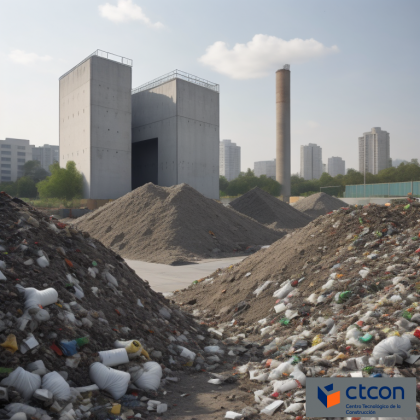From waste to resources: the transformative potential of Urban Solid Waste in sustainable construction

The world faces growing concern about greenhouse gas emissions and environmental sustainability. A recent study reveals that 62% of global emissions come from the extraction of materials, their processing and the manufacturing of goods, while the construction and maintenance of urban structures are responsible for almost half of the global use of materials and approximately 20% of greenhouse gas emissions. This situation raises a serious question about how to address the impact on the environment.
Municipal solid waste (MSW) is waste generated in urban and suburban areas as a result of people's daily activities and business operations. According to data from the Ministry for the Ecological Transition and Demographic Challenge of Spain, in 2019, around 22.7 million tons of this waste were generated, which is equivalent to approximately 481 kilograms of MSW per person per year. Globally, according to estimates by the United Nations Waste Knowledge Platform, approximately 2.01 billion tonnes of MSW were generated in 2020, equivalent to about 259 kilograms of MSW per person annually.
MSW incineration is a process by which solid waste is burned at high temperatures in special facilities known as waste incineration plants or incinerators. This practice has the main objective of reducing the volume of waste, minimizing its environmental impact and generating energy. However, this process produces ash (bottom ash or slag and fly ash) that represents between 10-30% of the original weight of the incinerated waste, so for every ton of MSW incinerated, between 100 and 300 kilograms of ashes. Bottom ash is the main waste generated in the incineration process. This material is porous, grayish and coarse containing mainly glasses, ceramics, minerals and ferrous and non-ferrous materials, along with small amounts of unburned materials and organic carbon. Fly ash constitutes the minority byproduct and occurs in the form of fine particles with a dark gray, powdery appearance.
The options for this waste are landfill disposal or recycling, but the leaching of contaminants such as heavy metals, chlorides, sulfates and toxic organic matter that can be carcinogenic, mutagenic and genotoxic, poses a risk to the environment. The use of these ashes as secondary construction material can generate various problems such as the leaching of contaminants mentioned above and/or the weakening and low durability of cementitious materials due to expansion problems.
Therefore, the need to pre-treat the ashes before its use as secondary construction material and even before its disposal in a landfill at the end of its useful life is evident.
Leaching tests have become an essential component to study the various solutions. These tests evaluate the mobility and release of solid material components when they come into contact with liquids. The results of these tests are essential to determine whether recycled materials are safe and viable for use in construction.
In this context, Royal Decree 646/2020, of July 7, establishes a legal and technical framework for the disposal of waste through landfill with the aim of guaranteeing the reduction of waste and establishing measures and procedures to reduce and prevent waste related negative effects on the environment. Defines limit values for waste according to its destination in landfills and requires compliance with specific criteria related to leaching and other soluble organic substances such as TOC (total organic carbon), COD (dissolved organic carbon), STD (total dissolved solids) , among others.
In summary, the recycling and reuse of highly available waste, such as MSW, is essential to reduce the consumption of natural raw materials and CO2 emissions. However, it is crucial to address the associated environmental challenges and ensure their environmental viability. Pretreatments and proper regulation can open a path to a more sustainable future in construction and waste management.
The TECNOCIR project, which is currently being implemented, aims to study pretreatments applied to different wastes, including MSW ashes, in order to improve their properties and reduce the harmful elements present in them for their subsequent use in the manufacturing of construction materials. The execution of this project is being carried out in collaboration with a consortium of companies characterized by a multidisciplinary approach and interregional scope. The 8 companies and 9 technology centers and research institutes involved represent a wide variety of highly relevant sectors in the construction industry. The total budget of the project is €5,087,870.
CTCON will contribute to the project by working together with the companies VALORIZA SERVICIOS MEDIOAMBIENTALES and URDECON using highly available waste to develop new technological, circular and sustainable solutions applicable in the construction sector, which allow the development of products such as cements, geopolymers, concretes and bituminous mixtures.